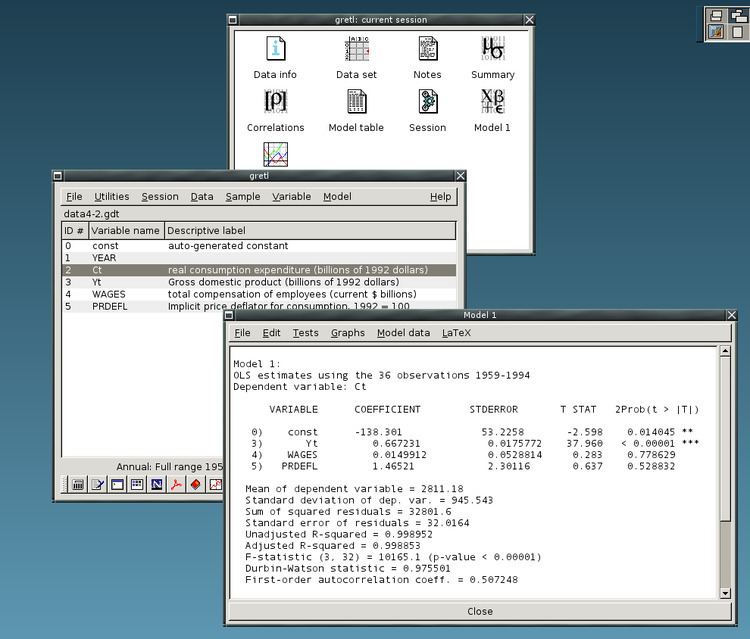Developer(s) the gretl team Development status Active | Preview release Through git Written in C | |
 | ||
Initial release January 31, 2000; 17 years ago (2000-01-31) Stable release 2016d / November 19, 2016; 3 months ago (2016-11-19) | ||
gretl is an open-source statistical package, mainly for econometrics. The name is an acronym for Gnu Regression, Econometrics and Time-series Library.
Contents
It has a graphical user interface (GUI) and can be used together with TRAMO/SEATS, R, Stata, Python, Octave, Ox and Julia. It is written in C, uses GTK+ as widget toolkit for creating its GUI, and uses gnuplot for generating graphs. As a complement to the GUI it also has a command-line interface.
gretl can output models as LaTeX files.
Besides English, gretl is also available in Albanian, Basque, Bulgarian, Catalan, Chinese, Czech, French, Galician, German, Greek, Italian, Polish, Portuguese (both varieties), Romanian, Russian, Spanish, Turkish and Ukrainian.
Gretl has been reviewed several times in the Journal of Applied Econometrics and in the Journal of Statistical Software.
Supported data formats
gretl offers its own fully documented, XML-based data format.
It can also import ASCII, Comma-Separated Values, databank, EViews, Excel, Gnumeric, GNU Octave, JMulTi, OpenDocument Spreadsheet, PcGive, RATS 4, SAS xport, SPSS, and Stata files. It can export to Stata, GNU Octave, R, Comma-Separated Values, JMulTi, and PcGive file formats.
Hansl
Gretl has its own scripting language, called Hansl (which is a recursive acronym for Hansl's A Neat Scripting Language). It is an interpreted language, whose primary scope is to automate repetitive tasks and make it easy for econometricians, not necessarily professional code writers, to create functions and procedures implementing techniques not already present in gretl.
Hansl is a fairly complete programming language, featuring loops, conditionals and complex data structures. Like other science-oriented programming languages, such as MATLAB and Julia, matrices are natively supported as a primitive variable type. The gretl add-ons known as function packages are typically written in Hansl.
Here's a simple example of Hansl
matrix A = {1, 2 ; 3, 4}matrix B = inv(A)matrix C = A*Bprint A B Cloop i=-3..3 printf "Phi(%d) = %7.3f", i, cdf(N, i)endloopRunning the above code produces
A (2 x 2) 1 2 3 4B (2 x 2) -2 1 1.5 -0.5C (2 x 2) 1.0000 0.0000 8.8818e-16 1.0000Phi(-3) = 0.001Phi(-2) = 0.023Phi(-1) = 0.159Phi( 0) = 0.500Phi( 1) = 0.841Phi( 2) = 0.977Phi( 3) = 0.999